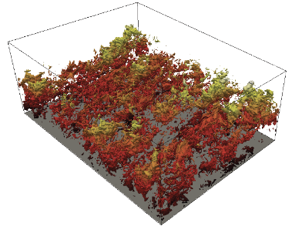A Self-similar Adverse Pressure Gradient Turbulent Boundary Layer
The efficient design and performance of many engineering systems relies on fluid flows remaining attached to aerodynamic surfaces in regions of adverse pressure gradient (APG). Separation of the boundary layer can potentially result in catastrophic consequences or at best sub-optimal performance. Adverse pressure gradients typically arise due to the presence of convex curved surfaces, such as those on wind turbine blades, turbo-machinery and aircraft wings. These configurations are difficult to systematically study, since the pressure gradient applied to the turbulent boundary layer (TBL) is constantly changing in the streamwise direction (Kitsios et al., 2011). There has been a long history of theoretical, experimental and numerical research into TBLs. However, the vast majority of this research has been centred on the zero pressure gradient (ZPG) case, while many aspects of turbulent structure and appropriate scaling of APG TBL remain largely unresolved.
The study of APG turbulent boundary layers (TBL) in an appropriate canonical form is, therefore, of utmost importance to understand the influence of the local pressure gradient. The most appropriate canonical APG TBL to study is arguably one that is self-similar. A self-similar TBL is defined as one in which each of the terms in the governing equations have the same proportionality with streamwise position (Townsend, 1956; Mellor and Gibson, 1966; George and Castillo, 1993, Kitsios et al., 2015). This also indirectly means that the non-dimensional pressure gradient, β, is constant over the domain of interest, where β = 0 for ZPG, β < 0 for a favourable pressure gradient (FPG), β > 0 for an APG, and immediately prior to separation β → ∞. This seminar will present research that we have been conducting towards setting up such a self-similar APG-TBL at the verge of separation using direct numerical simulations and the structure of this flow differs from that of a ZPG TBL
Prochains évènements
Voir l'agendaWebinaire Elizabeth GUAZELLI
Bodies of revolution in shear flows at low inertia
Elisabeth Guazzelli's research interests are in the field of particulate multiphase flows, such as fluidized beds, suspensions, sedimentation and sediment transport. She has spent her entire career as a CNRS researcher, leading an active and diversified research group at the IUSTI laboratory of the University of Aix-Marseille, and has now moved to the MSC (Matière et Systèmes Complexes) laboratory of the University Paris Cité. She is Rector of the International Center for Mechanical Sciences in Udine (Italy). She has been Associate Editor of the Journal of Fluid Mechanics since 2005 and is currently JFM Rapids Editor. Fellow of the American Physical Society and of the European Mechanics Society (EUROMECH), she is the recipient of the EUROMECH Fluid Mechanics Prize in 2016 and the APS Fluid Dynamics Prize in 2023. She was elected an international member of the Istituto Veneto di Scienze, Lettere ed Arti in 2020 and of the US National Academy of Engineering in 2021.

